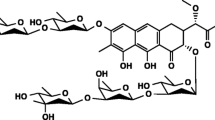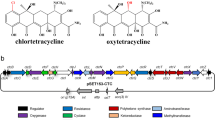Abstract
Staurosporine is the most well-known member of the indolocarbazole alkaloid family; it can induce apoptosis of many types of cells as a strong protein kinase inhibitor, and is used as an important lead compound for the synthesis of the antitumor drugs. However, the low fermentation level of the native producer remains the bottleneck of staurosporine production. Herein, integration of multi-copy biosynthetic gene cluster (BGC) in well characterized heterologous host and optimization of the fermentation process were performed to enable high-level production of staurosporine. First, the 22.5 kb staurosporine BGC was captured by CRISPR/Cas9-mediated TAR (transformation-associated recombination) from the native producer (145 mg/L), and then introduced into three heterologous hosts Streptomyces avermitilis (ATCC 31267), Streptomyces lividans TK24 and Streptomyces albus J1074 to evaluate the staurosporine production capacity. The highest yield was achieved in S. albus J1074 (750 mg/L), which was used for further production improvement. Next, we integrated two additional staurosporine BGCs into the chromosome of strain S-STA via two different attB sites (vwb and TG1), leading to a double increase in the production of staurosporine. And finally, optimization of fermentation process by controlling the pH and glucose feeding could improve the yield of staurosporine to 4568 mg/L, which was approximately 30-fold higher than that of the native producer. This is the highest yield ever reported, paving the way for the industrial production of staurosporine.
Keypoints
• Streptomyces albus J1074 was the most suitable heterologous host to express the biosynthetic gene cluster of staurosporine.
• Amplification of the biosynthetic gene cluster had obvious effect on improving the production of staurosporine.
• The highest yield of staurosporine was achieved to 4568 mg/L by stepwise increase strategy.





Similar content being viewed by others
Data availability
All data generated or analyzed during this study are included in this article and its supplementary information files.
References
An Z, Tao H, Wang Y, Xia B, Zou Y, Fu S, Fang F, Sun X, Huang R, Xia Y, Deng Z, Liu R, Liu T (2021) Increasing the heterologous production of spinosad in Streptomyces albus J1074 by regulating biosynthesis of its polyketide skeleton. Synth Syst Biotechnol 6(4):292–301
Aubry C, Pernodet J-L, Lautru S, Atomi H (2019) Modular and integrative vectors for synthetic biology applications in Streptomyces spp. Appl Environ Microbiol 85(16):e00485-e519
Baltz RH (2012) Streptomyces temperate bacteriophage integration systems for stable genetic engineering of actinomycetes (and other organisms). J Ind Microbiol Biotechnol 39(5):661–672
Bierman M, Logan R, O’Brien K, Seno ET, Nagaraja Rao R, Schoner BE (1992) Plasmid cloning vectors for the conjugal transfer of DNA from Escherichia coli to Streptomyces spp. Gene 116(1):43–49
Bilyk B, Horbal L, Luzhetskyy A (2017) Chromosomal position effect influences the heterologous expression of genes and biosynthetic gene clusters in Streptomyces albus J1074. Microb Cell Factories 16(1):5
Bilyk B, Luzhetskyy A (2014) Unusual site-specific DNA integration into the highly active pseudo-attB of the Streptomyces albus J1074 genome. Appl Microbiol Biotechnol 98(11):5095–5104
Bu QT, Li YP, Xie H, Li JF, Lv ZY, Su YT, Li YQ (2021) Rational engineering strategies for achieving high-yield, high-quality and high-stability of natural product production in actinomycetes. Metab Eng 67:198–215
Carrasco CFM, Chisholm JD, Van Vranken DL, Wilson WD, Bailly C (2002) DNA sequence recognition by the indolocarbazole antitumor antibiotic AT2433-B1 and its diastereoisomer. Nucleic Acids Res 30(8):1774–1781
Chater KF, Wilde LC (1980) Streptomyces albus G mutants defective in the SalGI restriction-modification system. J Gen Microbiol 116(2):323–334
Cheng J-W, Wang Y-B, He L, Qian H, Fu L-Z, Li H-B (2012) Optimization of fermentation process for the production of intracellular polysaccharide from Paecilomyces cicadae and the immuno-stimulating activity of intracellular polysaccharide. World J Microbiol Biotechnol 28(12):3293–3299
Chiu HT, Chen YL, Chen CY, Jin C, Lee MN, Lin YC (2009) Molecular cloning, sequence analysis and functional characterization of the gene cluster for biosynthesis of K-252a and its analogs. Mol Biosyst 5(10):1180–1191
El-Deeb IM, Jung S-J, Park B-S, Yoo Y-J, Choi K-H, Yang Y-M, Lee S-W, Kim I-T, Han D-K, Lee S-H (2011) A highly selective staurosporine derivative designed by a new selectivity filter. Bull Korean Chem Soc 32(5):1709–1714
Groom K, Bhattacharya A, Zechel DL (2011) Rebeccamycin and staurosporine biosynthesis: insight into the mechanisms of the flavin-dependent monooxygenases RebC and StaC. ChemBioChem 12(3):396–400
Guan H, Li Y, Zheng J, Liu N, Zhang J, Tan H (2019) Important role of a LAL regulator StaR in the staurosporine biosynthesis and high-production of Streptomyces fradiae CGMCC 4.576. Sci China Life Sci 62(12):1638–1654
Horbal L, Marques F, Nadmid S, Mendes MV, Luzhetskyy A (2018) Secondary metabolites overproduction through transcriptional gene cluster refactoring. Metab Eng 49:299–315
Huo L, Hug JJ, Fu C, Bian X, Zhang Y, Muller R (2019) Heterologous expression of bacterial natural product biosynthetic pathways. Nat Prod Rep 36(10):1412–1436
Jensen PR (2016) Natural products and the gene cluster revolution. Trends Microbiol 24(12):968–977
Jones JA, Koffas MA (2016) Optimizing metabolic pathways for the improved production of natural products. Meth Enzymol 575:179–193
Kang HS, Kim ES (2021) Recent advances in heterologous expression of natural product biosynthetic gene clusters in Streptomyces hosts. Curr Opin Biotechnol 69:118–127
Kieser T, Bibb MJ, Chater KF, Butter M, Hopwood D, Bittner ML, Buttner MJ (2000) Practical Streptomyces genetics. A laboratory manual. John Innes Foundation, Norwich
Lee NC, Larionov V, Kouprina N (2015) Highly efficient CRISPR/Cas9-mediated TAR cloning of genes and chromosomal loci from complex genomes in yeast. Nucleic Acids Res 43(8):e55
Li L, Wei K, Liu X, Wu Y, Zheng G, Chen S, Jiang W, Lu Y (2019) aMSGE: advanced multiplex site-specific genome engineering with orthogonal modular recombinases in actinomycetes. Metab Eng 52:153–167
Li L, Zheng G, Chen J, Ge M, Jiang W, Lu Y (2017) Multiplexed site-specific genome engineering for overproducing bioactive secondary metabolites in actinomycetes. Metab Eng 40:80–92
Li YP, Bu QT, Li JF, Xie H, Su YT, Du YL, Li YQ (2021) Genome-based rational engineering of Actinoplanes deccanensis for improving fidaxomicin production and genetic stability. Bioresour Technol 330:124982
Livak KJ, Schmittgen TD (2001) Analysis of relative gene expression data using real-time quantitative PCR and the 2(-Delta Delta C(T)) Method. Methods 25(4):402–408
Murakami T, Sumida N, Bibb M, Yanai K (2011) ZouA, a putative relaxase, is essential for DNA amplification in Streptomyces kanamyceticus. J Bacteriol 193(8):1815–1822
Novakova R, Nunez LE, Homerova D, Knirschova R, Feckova L, Rezuchova B, Sevcikova B, Menendez N, Moris F, Cortes J, Kormanec J (2018) Increased heterologous production of the antitumoral polyketide mithramycin A by engineered Streptomyces lividans TK24 strains. Appl Microbiol Biotechnol 102(2):857–869
Omura SIY, Hirano A, Nakagawa A, Awaya J, Tsuchya H, Takahashi Y, Masuma R (1977) A new alkaloid AM-2282 of Streptomyces origin taxonomy, fermentation, isolation and preliminary characterization. J Antibiot 30(4):275–282
Onaka H, Taniguchi S, Igarashi Y, Furumai T (2002) Cloning of the staurosporine biosynthetic gene cluster from Streptomyces sp. TP-A0274 and its heterologous expression in Streptomyces lividans. J Antibiot 55(12):1063–1071
Ongley SE, Bian X, Neilan BA, Muller R (2013) Recent advances in the heterologous expression of microbial natural product biosynthetic pathways. Nat Prod Rep 30(8):1121–1138
Sauer B (1994) Site-specific recombination: developments and applications. Curr Opin Biotechnol 5(5):521–527
Schroeder DR, Lam KS, Mattei JM, Hesler GA (1991) Staurosporine fermentation process [P]. Eur Patent 91102374.5
Stansfield LC, Pollyea DA (2017) Midostaurin: a new oral agent targeting FMS-like tyrosine kinase 3-mutant acute myeloid leukemia. Pharmacotherapy 37(12):1586–1599
Sun Y, Feng Z, Tomura T, Suzuki A, Miyano S, Tsuge T, Mori H, Suh JW, Iizuka T, Fudou R, Ojika M (2016) Heterologous production of the marine myxobacterial antibiotic haliangicin and its unnatural analogues generated by engineering of the biochemical pathway. Sci Rep 6:22091
Thiry M, Cingolani D (2002) Optimizing scale-up fermentation processes. Trends Biotechnol 20(3):103–105
Vandesompele J, De Preter K, Pattyn F, Poppe B, Van-Roy N, De Paepe A, Speleman F (2002) Accurate normalization of real-time quantitative RT-PCR data by geometric averaging of multiple internal control genes. Genome Biol 3(7):research0034.1
Wang Y, Wang L, Zhuang Y, Kong F, Zhang C, Zhu W (2014) Phenolic polyketides from the co-cultivation of marine-derived Penicillium sp. WC-29-5 and Streptomyces fradiae 007. Mar Drugs 12(4):2079–2088
Yin S, Li Z, Wang X, Wang H, Jia X, Ai G, Bai Z, Shi M, Yuan F, Liu T, Wang W, Yang K (2016) Heterologous expression of oxytetracycline biosynthetic gene cluster in Streptomyces venezuelae WVR2006 to improve production level and to alter fermentation process. Appl Microbiol Biotechnol 100(24):10563–10572
Zhao X, Wei W, Zong Y, Bai C, Guo X, Zhu H, Lou C (2022) Novel switchable ECF sigma factor transcription system for improving thaxtomin A production in Streptomyces. Synth Syst Biotechnol 7(3):972–981
Zhou TC, Kim BG, Zhong JJ (2014) Enhanced production of validamycin A in Streptomyces hygroscopicus 5008 by engineering validamycin biosynthetic gene cluster. Appl Microbiol Biotechnol 98(18):7911–7922
Acknowledgements
We thank the support from Professor Yinhua Lu (College of Life and Environmental Sciences, Shanghai Normal University), and Professor Weihong Jiang (Institute of Plant Physiology and Ecology, Chinese Academy of Sciences) for kindly providing the plasmids pCAP01a, pLB1, pLR4 and pLTG1.
Funding
This study was supported by the National Key Research and Development Program of China (2021YFC2102100).
Author information
Authors and Affiliations
Contributions
ZYZ, SBY, and ZXL performed experiments and data analysis. ZYZ, YJW, and JWT wrote the manuscript and conceived the study. MQF and SXC coordinated the project. All authors read and approved the final manuscript.
Corresponding authors
Ethics declarations
Ethics approval
This article does not contain any studies with human participants or animals performed by any of the authors.
Conflict of interest
The authors declare no competing interests.
Additional information
Publisher's note
Springer Nature remains neutral with regard to jurisdictional claims in published maps and institutional affiliations.
Supplementary Information
Below is the link to the electronic supplementary material.
Rights and permissions
Springer Nature or its licensor (e.g. a society or other partner) holds exclusive rights to this article under a publishing agreement with the author(s) or other rightsholder(s); author self-archiving of the accepted manuscript version of this article is solely governed by the terms of such publishing agreement and applicable law.
About this article
Cite this article
Zhang, Z., Yang, S., Li, Z. et al. High-titer production of staurosporine by heterologous expression and process optimization. Appl Microbiol Biotechnol 107, 5701–5714 (2023). https://doi.org/10.1007/s00253-023-12661-7
Received:
Revised:
Accepted:
Published:
Issue Date:
DOI: https://doi.org/10.1007/s00253-023-12661-7




